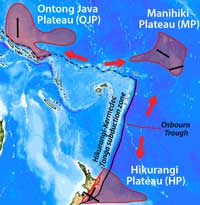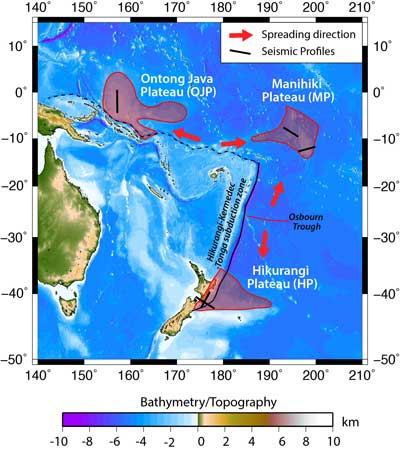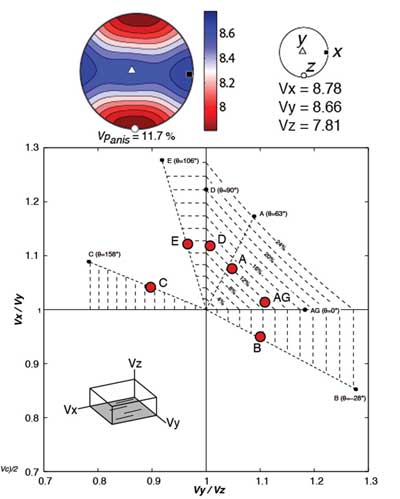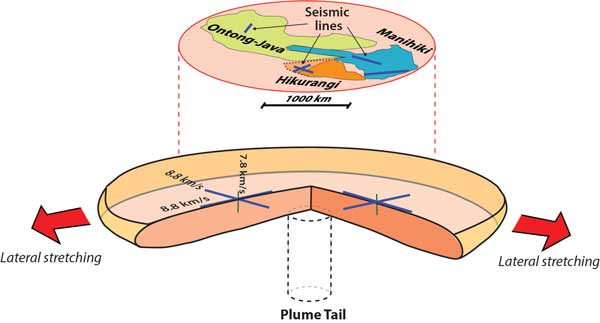 |
High mantle seismic P-wave-speeds as a signature for pancake-like flow in the upper mantle |
Tim Stern & Simon Lamb
School of Geography, Environment and Earth Sciences, Victoria University of Wellington,Wellington, 6012, New Zealand; tim.stern@vuw.ac.nz ; simon.lamb@vuw.ac.nz
This webpage is a summary of: Stern, T. A., Lamb, S., Moore, J., D.P., Okaya, D., and Hochmuth, K., 2020, High mantle seismic P-wave-speeds as a signature for gravitational spreading of superplumes: Science Advances, 6, no. eaba7118.
Mapping the variation of mantle seismic wave speeds with direction – giving rise to seismic anisotropy – is a powerful method to determine patterns of mantle flow. This work can also explain regions where seismic wave speeds are unusually high. We show below that the deduced flow field that existed beneath the world’s largest Large Igneous Provinces (LIPs) are most easily explained in terms of a fossilised superplume head.
It is well known that the typical upper mantle P-wave velocity is close to 8 km/s. This is shown by a compilation of several hundred upper mantle Pn-speed determinations for the continents, which has an average value of 8.07 km/s with a standard deviation of 0.2 km/s (Christensen & Mooney, 1995). However, these data have an asymmetric distribution with a thin, but significant, tail up to 8.9 km/s at the high end. It turns out that these high values are from the mantle beneath a Large Igneous Province (LIP) in Siberia (Cherepanova et al., 2013; Pavlenkova et al., 1996). What is the source of these usually high P-wave speeds found just beneath the Moho?
In this study (Stern et al., 2020), we document unusually high (8.7-9 km/s) upper mantle P-wave speeds (Pn-phase) from parts of another LIP in the Pacific Ocean, which are thought to make up the once contiguous Ontong-Java-Manihiki-Hikurangi (OJMH) plateau (Taylor, 2006) (Figure. 1). We show that the high speeds are unrelated to azimuthal direction of the survey lines along which the data were collected. In other words, azimuthal anisotropy is minimal. But because we have all three seismic components, we observe a splitting of the S-wave into Sv and Sh phases where Vsv ~ 0.9 Vsh. These P- and S-velocity data indicate strong radial anisotropy that closely mimics the AG fabric in olivine (Figure 2). This fabric has been observed in samples of peridotite dredged up from the sea bed of the western Pacific Ocean (Michibayashi et al., 2016). The simplest explanation for the AG fabric is isotropic horizontal dilation with vertical flattening, for example, the flow in a pancake mix as it is poured into a pan.

Figure 1. Location of dispersed fragments of the Ontong Java-Manihiki-Hikurangi Plateau. Seismic lines discussed in Stern et al. (2020) shown by solid black lines.

Figure 2. Vp-Flinn diagram showing positions for 6 types of olivine fabrics. Note the position of the AG fabric. AG fabric is also shown as a spherical projection for Vp, with a girdle of high P-wave speeds on the y and x axes.
Using both analogue and numerical models we show that an AG type fabric is predicted to occur in the top portion of a very large plume head in its last stage of gravitational collapse. This happens after the flow in the plume tail ceases to provide input into the plume head. The fabric is then frozen into the head as it cools, and is preserved over geological time in the mantle. The existence of an AG fabric in the upper mantle does not necessarily prove a plume origin for the high wave speeds we observe. It could, for example, be formed in the head of Rayleigh-Taylor instability that has an upper mantle origin (Elkins-Tanton & Hager, 2000).
However, factors that in our view favour the plume hypothesis are the volume of melt required and the length-scale over where the the high wave-speeds are observed. If we reconstruct the portions of the now dispersed Ontong-Java Plateau (OJP) (Figure 3), the high Pn speeds are observed over a horizontal distance of a 1000 km or more. This would seem too large compared to the scale of upper-mantle Rayleigh-Taylor instabilities, such as that proposed, for example, beneath the Sierra Nevada of California (Jones et al., 2014). Another factor is that the only other known region where such high Pn speeds have been reported is the mantle beneath Siberia (Kobussen et al., 2006), in the region of a LIP called the Siberian Traps. The OJMHP and the Siberian Traps (Coffin & Eldholm, 1994) are also the two largest known LIPs. This is consistent with our view (Stern et al., 2020) that only the largest plume heads will be capable of producing a pure AG fabric, because the plume flow field must be dominant enough to overcome any drag caused by motion of the overlying plate.

Figure 3. Cartoon summarising plume head model for AG fabric. The head undergoes lateral stretching and vertical compaction after delivery from the plume tail ceases.
References
-
Cherepanova, Y., Artemieva, I. M., Thybo, H., and Chemia, Z., 2013, Crustal structure of the Siberian craton and the West Siberian basin: An appraisal of existing seismic data: Tectonophysics, 609, 154-183.
-
Christensen, N. I., and Mooney, W. D., 1995, Seismic velocity structure and composition of the continental crust: a global review: J. Geophys. Res., 100, 9761-9788.
-
Coffin, M. F., and Eldholm, O., 1994, Large igneous provinces: Crustal structure, dimensions, and external consequences: Reviews of Geophysics, 32, 1-36.
-
Elkins-Tanton, L., and Hager, B., 2000, Melt intrusion as a trigger for lithospheric foundering and the eruption of the Siberian flood basalts: Geophysical Research Letters, 27, 3937-3940.
-
Jones, C. H., Reeg, H., Zandt, G., Gilbert, H., Owens, T. J., and Stachnik, J., 2014, P-wave tomography of potential convective downwellings and their source regions, Sierra Nevada, California: Geosphere, 10, 1-29.
-
Kobussen, A. F., Christensen, N. I., and Thybo, H., 2006, Constraints on seismic velocity anomalies beneath the Siberian craton from xenoliths and petrophysics: Tectonophysics, 425, 123-135.
-
Michibayashi, K., Mainprice, D., Fujii, A., Uehara, S., Shinkai, Y., Kondo, Y., Ohara, Y., Ishii, T., Fryer, P., Bloomer, S. H., Ishiwatari, A., Hawkins, J. W., and Ji, S., 2016, Natural olivine crystal-fabrics in the western Pacific convergence region: A new method to identify fabric type: Earth and Planetary Science Letters, 443, 70-80.
-
Pavlenkova, N. I., Pavlenkova, G. A., and Solodilov, L. N., 1996, High velocities in the uppermost mantle of the Siberian craton: Tectonophysics, 262, 51-65.
-
Stern, T. A., Lamb, S., Moore, J., D.P., Okaya, D., and Hochmuth, K., 2020, High mantle seismic P-wave-speeds as a signature for gravitational spreading of superplumes: Science Advances, 6, eaba7118.
-
Taylor, B., 2006, The single largest oceanic plateau: Ontong Java-Manihiki-Hikurangi: Earth and Planetary Science Letters, 241, 372-380.
last updated 28th April, 2021 |
